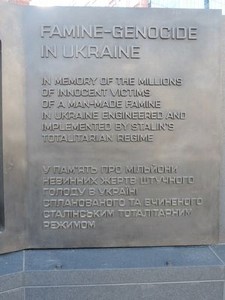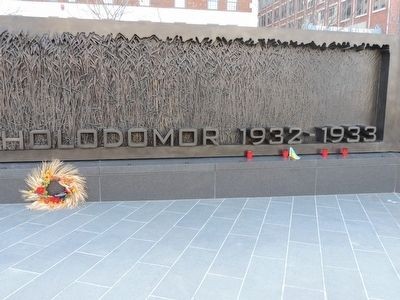Holodomor Memorial; Famine-Genocide in Ukraine
Introduction
Text-to-speech Audio
Images
The Famine-Genocide in Ukraine Marker. Scholars estimate that 40 million perished in famines in areas controlled by communist regimes in the Soviet Union, North Korea, China, and Cambodia during the 20th century

Signage on the Massachusetts Avenue side of the monument where visitors continue leaving flowers and icons in remembrance of those who died in the famine-genocides of the 1930s under Stalin.

Famine-Genocide in Ukraine Memorial

Backstory and Context
Text-to-speech Audio
The famine had been predicted as far back as 1930 by academics and advisers to the Ukrainian Soviet Socialist Republic government, but little to no preventive action was taken. The famine affected the Ukrainian SSR as well as the Moldavian Autonomous Soviet Socialist Republic (a part of the Ukrainian SSR at the time) in the spring of 1932 and from February to July 1933, with the greatest number of victims recorded in the spring of 1933. Between 1926 and 1939, the Ukrainian population increased by 6.6%, whereas Russia and Belarus grew by 16.9% and 11.7%, respectively.
From the 1932 harvest, Soviet authorities were able to procure only 4.3 million tons of grain as compared with 7.2 million tons obtained from the 1931 harvest. Rations were drastically cut back and during the winter of 1932–33 and spring of 1933 people in many urban areas perished. Urban workers were supplied by a rationing system (and therefore could occasionally assist their starving relatives of the countryside), but rations were gradually cut; and by the spring of 1933, urban residents also faced starvation. At the same time, workers were shown agitprop movies, where all peasants were portrayed as counterrevolutionaries hiding grain and potatoes at a time when workers, who were constructing the "bright future" of socialism, were starving.
The first reports of mass malnutrition and deaths from starvation emerged from two urban areas. By mid-January 1933, there were reports about mass "difficulties" with food in urban areas, which had been under supplied through the rationing system, and reports that might have detailed the number of victims were suppressed and efforts were made to prevent people from fleeing the region. The tragedy was greatly exacerbated by Stalin's efforts to crush those who supported Ukrainian independence. While some of the causes of the famine were natural, the actions taken by Soviet leaders were not. "Food supply was not mismanaged by Utopian dreamers," explained Anne Applebaum, a Pulitzer Prize winning journalists who studied the the tragedy in Ukraine, "It was weaponised."
